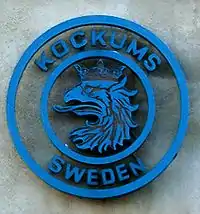Saab Kockums
Saab Kockums AB is a shipyard in Malmö, Sweden, owned by the Swedish defence company Saab Group.[1] While having a history of civil vessel construction, Kockums' most renowned activity is the fabrication of military corvettes and submarines.

Kockums worked with Northrop Grumman and Howaldtswerke-Deutsche Werft (HDW) to offer a Visby-class corvette derivative in the American Focused Mission Vessel Study, a precursor to the Littoral Combat Ship program. It competed with several other concepts, including Norway's Skjold class (part of a Raytheon led group).
History

The submarine conflict
As a result of the Swedish shipyard crisis (sv) which heavily affected the industry during 1969–1985, due to heavy competition from the Far East and the 1973 oil crisis, Kockums was placed under the control of the Swedish state through the state-owned company Svenska Varv and its successor company Celsius AB (sv) from 1979 until 1999. Having implemented a highly advanced variety of the Stirling engine for low noise submarine propulsion, Kockums was considered to have strategic value for the Swedish Navy. During the period of state ownership, Kockums acquired Karlskronavarvet (sv), the operator of the Karlskrona shipyards, in 1989. In 1999, following the acquisition of Celsius AB by Saab, Kockums was sold to the German shipbuilding company HDW. In 2005, HDW was bought by the German industrial conglomerate Thyssen Krupp.[2] The time after 1999 was rife with conflicts between Kockums' only Swedish customer, the Defence Materiel Administration (FMV), and Kockums' German owners. The Swedish view was that the technical advancements made in collaboration between Kockums and FMV ought to be used to create a new generation of submarine for lucrative export: the A26 submarine. On the German side, the A26 project was said to be regarded as a high-risk project that could lead to uncontrollably growing costs.[3] Superficially, the major source of conflict seemed to be that neither ThyssenKrupp nor FMV would accept carrying unforeseen development costs. As several technical innovations to be implemented in the A26 were kept in classified status at the FMV, ThyssenKrupp argued that the implied costs were too difficult to predict. This deadlock persisted for months until the FMV decided to cancel the order of the A26 submarines.
Globally, the conflict also concerned the general business strategy. ThyssenKrupp insisted that Kockums ought to discontinue large submarine construction and to focus on the development of small submarines. Meanwhile, anonymous sources from inside Kockums claimed that ThyssenKrupp's goal in acquiring Kockums was never to reach synergies with HDW, but only to eliminate its main competitor.[2]
When the Crimea crisis erupted in March 2014, Sweden's defence interests in the future of Kockums came under closer scrutiny. The turning point was described by the chairman of the Swedish parliament's Standing Committee on Defense (SCD), Peter Hultquist:[4]
The wheels have turned. The government, possibly in response to Russia's aggression in Crimea and the Ukraine, has decided that a strong industrial defense capacity that is Swedish-controlled will be the cornerstone that underpins defense policy and future capability.
In the search for a partner to develop the next generation of submarines, the FMV approached the SAAB Group. During autumn 2013, Saab tried to reach an agreement to buy Kockums from ThyssenKrupp. ThyssenKrupp demanded to keep its monopoly position in the A26 deal, which Saab refused to accept, causing the negotiations to fail. Saab responded by approaching Kockums' engineers, offering them employment at Saab Naval Systems. Thyssen Krupp tried in vain to keep its engineers at Kockums, proposing an extra month's salary.[3]
The hostility towards ThyssenKrupp reached a new level during the Kockums equipment repossession incident on 8 April 2014. As per protocol, two military trucks accompanied by armed soldiers entered the Kockums shipyard in Malmö to reclaim all materiel and equipment belonging to the Defence Materiel Administration (Sweden), FMV, as well as all secret blueprints and images. By orders from a manager, Kockums staff tried to sabotage the repossession by locking the gates with the repossession crew and escort still inside.[5] According to a spokesperson from FMV this is the first time they have had to forcefully repossess equipment.[6]
Shortly after, ThyssenKrupp initiated discussions to sell Kockums to Saab. The deal was finalized on 22 July 2014, making Saab the new owner of Kockums.[7]
Exports
![]() Australia: In November 2014 Saab formally made a bid in SEA 1000, the Royal Australian Navy's replacement program for the six Collins-class submarines still in service. Defence Minister David Johnston stated that "We need to decide quickly and whatever we do decide will be in the best interests of the entire nation".[8] The Australian Government had been ready to buy the more expensive Sōryū-class submarine offered by the Japanese Maritime Self Defence Force;[9] however, internal opposition had forced the government to have an open tender for the multi-billion-dollar program.[10][11][12] Australia subsequently selected Naval Group (formerly DCNS) France and their Shortfin Barracuda submarines to replace the Australian Collins class.
Australia: In November 2014 Saab formally made a bid in SEA 1000, the Royal Australian Navy's replacement program for the six Collins-class submarines still in service. Defence Minister David Johnston stated that "We need to decide quickly and whatever we do decide will be in the best interests of the entire nation".[8] The Australian Government had been ready to buy the more expensive Sōryū-class submarine offered by the Japanese Maritime Self Defence Force;[9] however, internal opposition had forced the government to have an open tender for the multi-billion-dollar program.[10][11][12] Australia subsequently selected Naval Group (formerly DCNS) France and their Shortfin Barracuda submarines to replace the Australian Collins class.
In December 2014 it was announced that leading global Dutch shipbuilder Damen Shipyards entered into an agreement with Saab to develop, offer, and build next-generation submarines, initially focusing on the planned replacement of 4 Walrus Class submarines currently used by The Royal Netherlands Navy.
The Kockums Crane

The shipyard formerly possessed a 138-metre high crane, known as the Kockums Crane, built in 1973/74 and capable of lifting 1500 tons, making it the largest crane in the world when it was installed in 1974.[13] The crane was not used much because of the Swedish shipyard crisis of the late 1970s and 1980s. It was used the last time in 1997 for lifting the foundations of the high pillars of the Oresund Bridge.
The crane was sold the first time in the early 1990s to the Danish company Burmeister & Wain, but the company went bankrupt shortly thereafter. It was later sold to a Korean company, Hyundai Heavy Industries. The crane was a landmark of Malmö from its time of construction until its dismantling before being shipped to Ulsan in South Korea in the summer of 2002.[13]
Ships built by Kockums
- M/T Frans Suell
- MV Sovetskaya Latviya
- Visby-class of stealth corvettes
- Landsort-class mine countermeasures vessel
- Styrsö-class mine countermeasures vessel
- Näcken-class submarine
- Västergötland-class submarine
- Södermanland-class submarine
- Gotland-class submarine
- HSwMS Orion (A201)
- Unmanned surface vehicle Piraya
- MS Celebration
- Jubilee
Ships built with Kockums technology
- Collins-class submarines
- Archer-class submarines (updated Västergötland class)
- Sōryū-class submarine
Future ships
- Blekinge-class submarine (A26 submarine, replacement of the Södermanlands class submarine)
References
- "Saab Completes Acquisition of TKMS AB (Kockums)". Saab (Press release). 22 July 2014. Retrieved 23 October 2017.
- "Sanningen om den hemliga gryningsräden mot Kockums" [The truth about the secret dawn raid on Kockums]. Dagens Nyheter (in Swedish). SE. Retrieved 24 August 2014.
- Kleja, Monica. "Spelet som fick Thyssen Krupp att ge upp Sverige" [The game that got Thyssen Krupp to give up Sweden]. Ny Teknik (in Swedish). SE. Retrieved 25 August 2014.
- "Sweden's Goals Fuel Saab's Acquisitions". Defense News. Retrieved 25 August 2014.
- Sköld, Josefin (5 May 2014). "Sanningen om den hemliga gryningsräden mot Kockums". Dagens Nyheter. Retrieved 18 March 2015.
- Sköld, Josefin (5 May 2014). "Sanningen om den hemliga gryningsräden mot Kockums". Dagens Nyheter. Retrieved 18 March 2015.
- Abrahamson, Håkan. "Klart att Saab köper Kockums" [Clearly Saab buying Kockums]. Ny Teknik (in Swedish). SE. Retrieved 25 August 2014.
- McPhedran, Ian (8 November 2014). "Australian jobs promise as Sweden's Saab Group bids for Navy's $20 billion plus submarine project". news.com.au. News Corp Australia Network. Archived from the original on 24 January 2015. Retrieved 12 November 2014.
- McPhedran, Ian (8 September 2014). "New Japanese submarines to cost Abbott Government $20 billion". news.com.au. News Corp Australia Network. Archived from the original on 26 March 2016. Retrieved 12 November 2014.
- McDonald, Matt (10 November 2014). "Swedish bid to build Australia's submarines". Manufacturers' Monthly. Ferret. Archived from the original on 12 November 2014. Retrieved 12 November 2014.
- Yaxley, Louise (16 October 2014). "Some Liberals lobbying for new submarines to be built in Australia". AM. Australian Broadcasting Corporation. Retrieved 12 November 2014.
- "Japan submarine deal risks SA ties with China: SA Minister Martin Hamilton-Smith". Yahoo! 7 News. Australian Broadcasting Corporation. 15 October 2014. Archived from the original on 12 November 2014. Retrieved 12 November 2014.
- Larsson, Mats. "Kockums AB". Nationalencyklopedin (in Swedish). SE. Retrieved 12 September 2010. (subscription required)
External links
| Wikimedia Commons has media related to Kockums AB. |